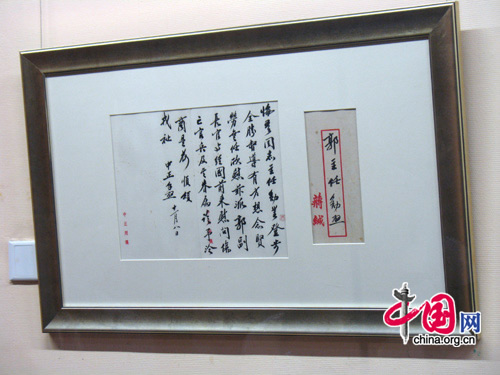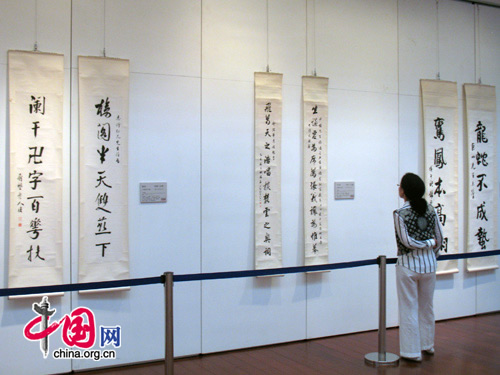Calligraphy exhibition explores Chinese history
An exhibition of the calligraphies of renowned politicians, writers and artists who lived and gained fame during China's republic period (1912-1949) is now on show in Beijing's Yanhuang Art Museum.
![Sun Yat-sen's 'Tao Tao Ting' was written in 1919 for the first Chinese restaurant in Japan. [China.org.cn] Sun Yat-sen's 'Tao Tao Ting' was written in 1919 for the first Chinese restaurant in Japan. [China.org.cn]](http://images.china.cn/attachement/jpg/site1007/20100525/0013729e78490d65d28d02.jpg) |
|
Sun Yat-sen's "Tao Tao Ting" was written in 1919 for the first Chinese restaurant in Japan. [China.org.cn] |
Jiahe Room's Collection features about 200 pieces from a private collection that are revealed to the public for the first time in China.
"Besides Xu Beihong, Zhang Daqian, Qi Baishi, whose works are frequently seen in art market, there are a lot of politicians' handwritings such as Sun Yat-sen, Chiang Kai-shek, Huang Xing and Zhou Enlai," said Xu Shiyan, manager of painting and calligraphy department of Beijing Tranthy International Auction Co., Ltd. "These works are not allowed to be auctioned in China."
The 50-year-old owner refers to himself simply as "master of Jiahe Room" – the room in his home where he stored the paintings. He had taken the name, Jiahe Room, from a calligraphy piece. A landscape designer, he has spent more than 20 years collecting artworks and now owns about 10,000 pieces of traditional Chinese paintings and calligraphies, jade ware and pottery.
 |
|
Chiang Kai-shek's official letter to a general. [China.org.cn] |
The works, which have high artistic ad social meanings according to Xu, are arranged in time sequence and divided into two groups by the revolution of 1911. Artists in first group were born between 1820 and 1860 and received traditional Chinese education. Their calligraphies are closer to the classic style. Artists in the second group were born in the late 1800s and were greatly influenced by Western culture. Their works are more innovative. The two groups together illustrate the artistic panorama at that time.
 |
|
A visitor stands in front of calligraphies. [China.org.cn] |
Unlike other exhibitions of its kind, many works are personal correspondences, travel notes, opinions on historical issues and excerpts from Chinese classics. A poem written by Wang Jingwei in 1942, known as his formation of a Japanese-supported collaborationist government in Nanjing during World War II, showed his hesitation of working with Japanese.
"These works allow us to see through the veil of time and get to know the real history, which is our purpose of holding this event," Xu said.
The works will also serve as a standard with which to judge the authenticity of Chinese art works. According to Xu, people's handwritings are easier to recognize than their paintings. These works give collectors an opportunity to better know artists' signatures and will help them distinguish real works from fake ones.
Sponsored by China Minsheng Banking Corp., Ltd., the exhibition will run until May 28 before moving to Shanghai and Qingdao in June.
 0
0 






